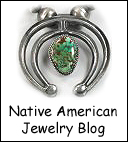 Squash
Blossom Symbolism Squash
Blossom Symbolism
Corn,
squash and beans are the traditional mainstays of the southwestern diet, culture
and symbolism and are used in many ways in art and ceremony. The squash blossom
represents abundant life. What
is a squash blossom necklace? "Some say the
Navajo squash blossom necklace has a connection to southwestern agriculture, other
say the the spread petal design is just that, a design, and that is was only after
white man asked, “what is this, what does it mean” did the name squash blossom
come to be. Yet others say the Navajo copied a similar Spanish design of the pomegranate
– look at the end of a pomegranate sometime and compare it to the “squash blossom”
bead. "The Navajo word for the “squash blossom”
bead means “bead that spreads out” so it would seem to me that the original intent
was design, not squash. But what do I know, I wasn’t around in 1880 when spread
beads first appeared. "Whichever is the true
account, it seems that originally Navajo silversmiths used simple silver bead
necklaces to suspend their naja pendants. In about 1880, the tri-petal form that
we know as a squash blossom bead appeared. "At
first, tri-petal silver beads were simply interspersed with plain beads in a naja
necklace. Then stones began to be added to the blossom beads partly to please
the maker but mostly to satisfy customer demand. "While
usually associated with Navajo silversmiths, squash blossom necklaces are also
made and worn by Pueblo and Zuni people. Zuni necklaces usually feature needlepoint
designs. Although there can be any number of squash blossoms on each side of a
necklace, there are often six on each side, making twelve squash blossoms and
one central naja. "Full size squash blossom
necklaces are often quite large and heavy and most suitable for occasional ceremonial
wear. Smaller, lighter versions are made to be worn as everyday jewelry."
- Paula What is a Naja?The
horseshoe shaped naja originated with the Moors in Spain. It is a good luck charm
to ward off the evil eye. It was often used on the browband of Moorish Horses.
It is thought that it came to Mexico via the Spanish Moors and from there was
adopted by the Navajo Indians. The naja is the base pendant of many ornate squash
blossom necklaces: read
more . . .
|